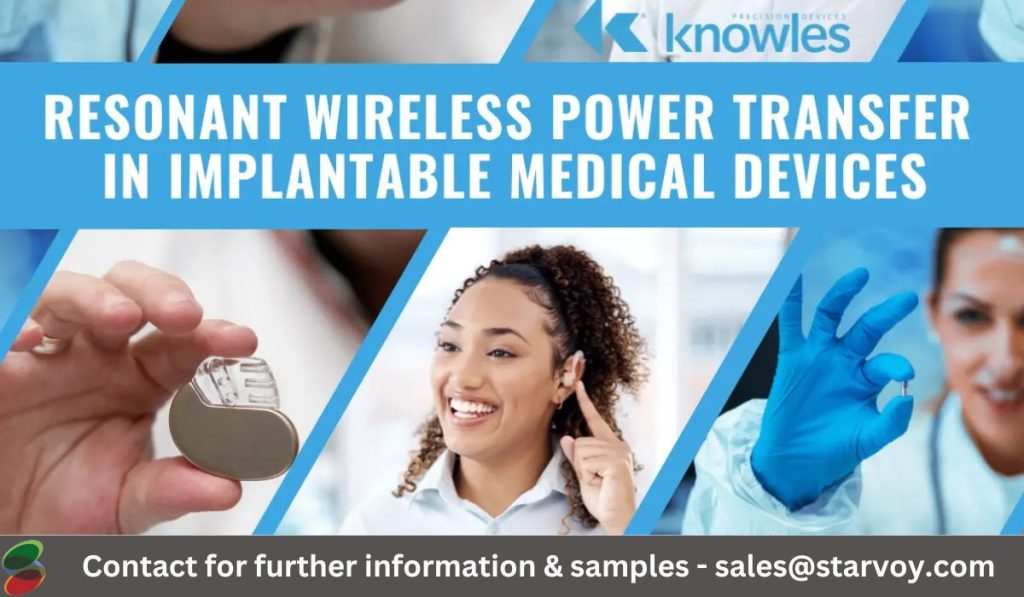Knowles: Resonant Wireless Power Transfer in Implantable Medical Devices
Starvoy Technolgies represents Knowles Precision Devices across Canada – the below recently appeared on Knowles’ blog. For further information on the below – reach out to your account manager, or [email protected]
With the rising prevalence of cardiovascular, orthopedic, and other chronic conditions, and an increase in the number of patients needing care, the demand for implantable medical devices continues to increase.

Today, many medical implantable devices are limited by the lifetime of their primary battery. That power is finite, and battery replacement can be inconvenient, costly, and painful for patients. Wired sources aren’t a suitable alternative due to safety concerns, including increased risk for infections and disease. Devices like pacemakers, neural stimulators, cochlear implants, retinal implants and drug delivery systems all benefit from safe, effective means of wireless charging.
The Rise of Resonant Wireless Power Transfer
The growing popularity of resonant wireless power transfer (RWPT) is a confluence of three trends in the medical implantable device space:
- Miniaturization: Implantable medical devices continue to shrink, and efficient wireless charging is critical for maintaining functionality without increasing a device’s footprint.
- Tighter Energy Efficiency Specifications: With more devices requiring consistent power, there’s a growing desire to optimize charging systems to reduce energy loss and improve overall system efficiency.
- High Standards for Safety and Reliability: Making implantable devices safer calls for technological advancements in power delivery.
RWPT is known for efficiency and the ability to transfer power over longer distances with minimal loss. In implantable devices, RWPT eliminates the need for wires, enhances device longevity and reduces the risk of infection.
Resonant Wireless Power Transfer Systems
RWPT systems are designed to leverage the oscillating magnetic fields between the TX and RX coils to transfer power wirelessly. In terms of components, the transmitter, consisting of the battery, inverter, DC-to-DC converter and TX coil, is located outside the body. The receiver, which includes the RX coil, rectifier, DC-to-DC converter and load, is inside the body.

When RF signals are received, they’re converted into usable direct current (DC) power, which can be stored or used to power the implantable device. The transmitter and receiver are tuned to the same frequency to maximize that energy transfer. This technique is resonant by nature, which minimizes energy loss during transfer and ensures the implantable device receives adequate power.
Inherently, RWPT accommodates compact design and efficient receiving coils because the receiver coil and associated electronics are integrated into the device itself. This also ensures energy transmission even if the TX and RX coils aren’t perfectly aligned or are farther away.
Capacitors: The Heart of RWPT Systems
Capacitors play a crucial role in maintaining system resonance and efficiency. In association with the RX coil, resonant capacitors are used in the resonant tank circuit to fine-tune the resonant frequency. Further, bypass and decoupling capacitors filter out noise and smooth voltage fluctuations to stabilize the voltage supply. A variety of other capacitors perform filtering functions to keep the signal smooth too.
Ceramic capacitors are well-positioned to fill these roles because of their:
- Small size
- High capacitance values
- Low equivalent series resistance (ESR)
- Wide voltage ratings
- Fast charging and discharging
- Temperature stability
- High dielectric strength
Knowles Precision Devices has a long history of testing and screening military-grade reliability specifications (MIL-SPECS) for defense and military applications, and apply the same rigor to medical applications, including implantable medical devices. Continuing to innovate around implantable medical devices calls for a commitment to innovation in wireless charging, and Knowles are devoted to providing high-quality components to serve as the foundation of your design.
View Catalogue & Datasheets
P.s. If you don't see what you are looking for reach out to discuss custom options.
Additional Medical Solutions
Non-Magentic Componenets
Avoid Interference when designing your MRI &NMR machines, or other magnetic sensitive systems.
Medical Implantables
Medical implantable devices require High Reliability Components to perform all the time, every time!
